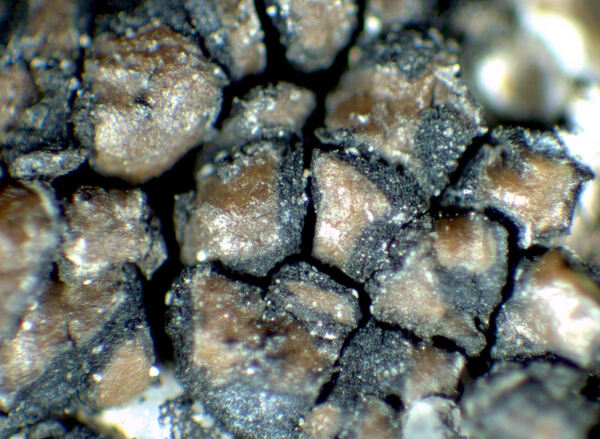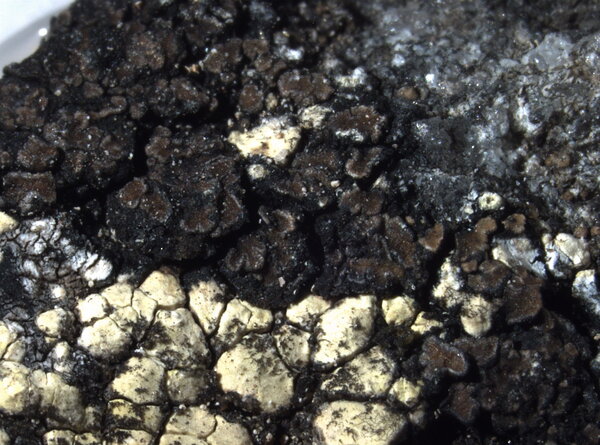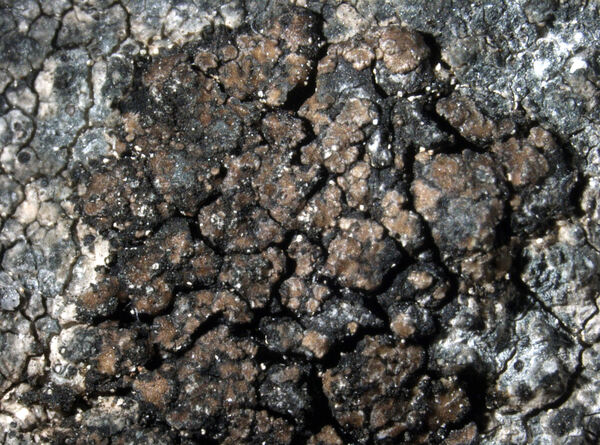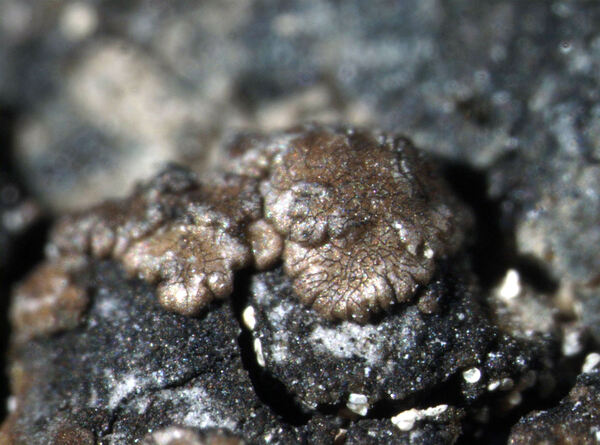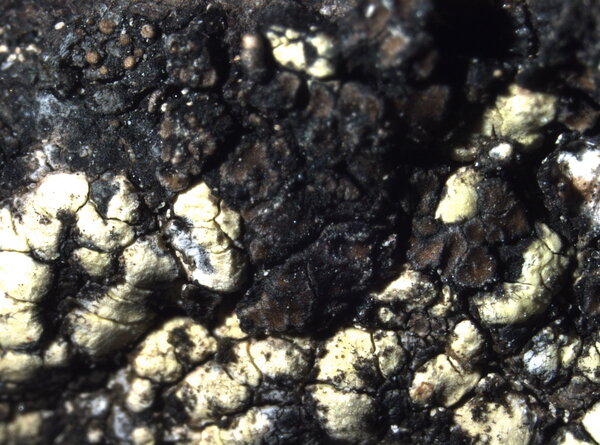Miriquidica intrudens (H. Magn.) Hertel & Rambold
Mitt. bot. Staatss. München, 23: 386, 1987. Basionym: Lecanora intrudens H. Magn. - Bot. Not.: 8-9, 1942.
Synonyms:
Description: Thallus crustose, areolate, dark chestnut brown to brown-black, glossy, sorediate, starting the life-cycle on the thalli of crustose lichens, especially yellow Rhizocarpon-species, forming up to 1.5 cm wide islands on the thalli of the host. Areoles contiguous, almost subsquamulose, (0.2-)0.4-2(-3) mm wide, concave with a central depression, paler along the somehow raised margins; soredia black, mainly marginal, mostly 10-15 mm in diam., sometimes coalescing into irregular 0.2-0.6 mm wide, soralia-like patches. Apothecia rare, lecideine, 0.3-0.7(-1) mm across, immersed to sessile, with a brown-black to black disc and a thin proper margin. Proper exciple olivaceous brown or olive-green in outer part, colourless within; epithecium brown, N-; hymenium colourless 40-75 µm high, I+ blue; paraphyses branched and anastomosing, 1.7-2 µm thick at mid-level, the apical cells more or less clavate, 2-3 µm wide; hypothecium colourless. Asci 8-spored, clavate, approaching the Lecanora-type, but with a weakly amyloid tholus, lacking an amyloid zone above the axial body and with a thin outer amyloid wall layer. Ascospores 1-celled, hyaline, ellipsoid to oblong, (7-)8-10(-18) x (2-)4-6(-8) µm. Pycnidia rare, black, immersed. Conidia thread-like, curved, 15-24 x 0.5-1 µm. Photobiont chlorococcoid. Spot tests: cortex and medulla K- or rarely K+ yellow, C-, KC-, P-, UV-; soredia N+ violet. Chemistry: miriquidic acid, rarely replaced by stictic acid.
Growth form: Crustose
Substrata: rocks
Photobiont: green algae other than Trentepohlia
Reproductive strategy: mainly asexual, by soredia, or soredia-like structures (e.g. blastidia)
paras crustose lichens, especially yellow Rhizocarpon spp.
Commonnes-rarity: (info)
Alpine belt: rare
Subalpine belt: very rare
Montane belt: absent
Dry submediterranean belt: absent
Humid submediterranean belt: absent
Padanian area: absent
pH of the substrata:
1 2 3 4 5
Solar irradiation:
1 2 3 4 5
Aridity:
1 2 3 4 5
Eutrophication:
1 2 3 4 5
Poleotolerance:
0 1 2 3
Altitudinal distribution:
1 2 3 4 5 6
Rarity
absent
extremely rare
very rare
rare
rather rare
rather common
common
very common
extremely common
Loading data...
Occurrence data
Predictive map
Growth form: Crustose
Substrata: rocks
Photobiont: green algae other than Trentepohlia
Reproductive strategy: mainly asexual, by soredia, or soredia-like structures (e.g. blastidia)
paras crustose lichens, especially yellow Rhizocarpon spp.
Commonnes-rarity: (info)
Alpine belt: rare
Subalpine belt: very rare
Montane belt: absent
Dry submediterranean belt: absent
Humid submediterranean belt: absent
Padanian area: absent
pH of the substrata:
| 1 | 2 | 3 | 4 | 5 |
Solar irradiation:
| 1 | 2 | 3 | 4 | 5 |
Aridity:
| 1 | 2 | 3 | 4 | 5 |
Eutrophication:
| 1 | 2 | 3 | 4 | 5 |
Poleotolerance:
| 0 | 1 | 2 | 3 |
Altitudinal distribution:
| 1 | 2 | 3 | 4 | 5 | 6 |
Rarity
absent
extremely rare
very rare
rare
rather rare
rather common
common
very common
extremely common
Loading data...
Occurrence data
Predictive map


